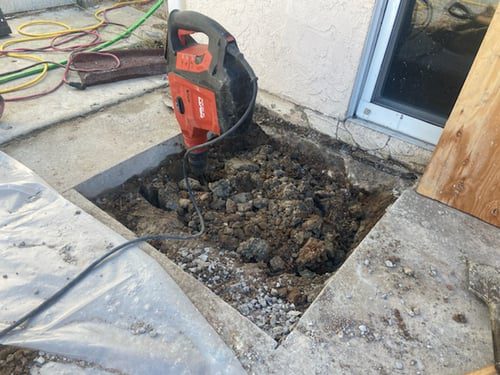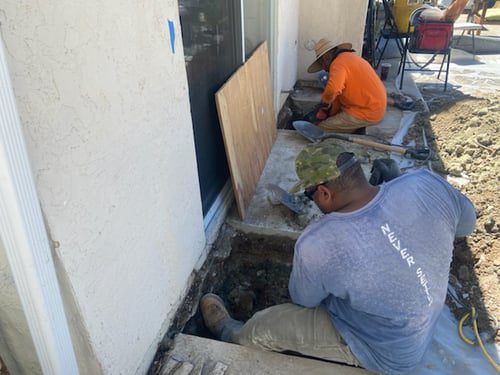It can be intimidating to know whether your home has foundation issues. You might see cracks here and there. Doors and windows are difficult to open. And all you’ve heard is foundation repair is expensive. The thought of it alone is stressful.
Hearing about cost might intimidate you. But there is always the thought, “what will this cost me?” And with that, “What can make the cost go down?
This is why Dalinghaus Construction is here: to help you. We’ve inspected over ten thousand homes. We’ve repaired thousands of homes. It’s by this point we understand the elements of the cost of foundation repair. If you’re looking to make your cost cheaper, we’ll lay out some options for you.
Bear in mind these options, while they will save you money, can take a large expense of time.
Here are some things that can be done to make your foundation bill cheaper
Warning: Do these at your own risk. Any work you put into wanting your bill to be cheaper doesn’t guarantee a cheaper bill due to many factors we will go into.
Option: Removing concrete slabs
You can remove the slabs where we place piers on your own. That or have a concrete or demo company do the removal.
This typically doesn’t happen. If you did want to do this on your own, each slab removed would be 30 inches by 30 inches.

The risk: You may not remove the concrete in the correct place. You might think you do, but that isn’t always the case. So the crew will have to do the removal. You won’t get the work you put in off your bill.
While that risk is scary, we won’t leave you in the dark about where to remove everything. We send you the production plan and where we plan to have the piers located. And if you’re still unsure from there, our team has no problem showing you what location installations will happen.
Option: Digging the holes where piers and brackets will be installed
This is not one I recommend you do. Dalinghaus Construction’s production crew is three people per team. Assuming the footing on your home is about 18 inches underground, our production team typically can do the concrete slab removal and excavate the desired depth the same day. This isn’t always the case, but the point is our teams are trained for this. They’re efficient.

The deeper the footing on the home, the longer it will take the team to dig. It’ll take longer for you, too.
Keeping this in mind, digging where piers will be installed on your own will take a lot of time on your own. While the cost of your bill might go down, you may be spending more of your hard-earned time digging.
Note: Sometimes digging the holes on your own can be at your own risk. You may not have the exact spot the team needs to use for lifting. This said we will help you get those details as accurate as possible. There is no problem helping you out, and we don’t want you putting in work for it to be unnecessary. Remember the movie Holes where the kids dig around the lake for that treasure in what seems like random areas? We have no problem marking the spots for you. With less treasure, though.
And if you enjoy digging in your spare time–we know you exist–some soils are more difficult to excavate than others. Sometimes soils and clays clump together, becoming more and more difficult to break and remove. Some are harder. Others are as smooth as a baby’s butt. Though that may be more incentive to get your pump on with those shovels. To each their own.
The production teams have the equipment to break up those soils and remove them efficiently. We use straight and curved shovels as well as demolition hammers–which aren’t cheap to buy on your own.
As for how much it would save in cost, it varies. It can maybe be around $300 per hole excavated, though this is not a guaranteed number. This also assumes your home’s footing is 18-inches. If you have ten piers installed, you could save $3,000 in that instance.
If I have the necessary tools for the production team, can they borrow my equipment at a cheaper cost?
While that may be a kind gesture from the goodness of your heart, the short answer is no.
Our production teams have the necessary equipment to get the job done. Having them use equipment they’re unfamiliar with can be a hazard and a legal issue waiting to happen.

And we won’t run the potential risk of damaging your equipment. That can be a hassle to deal with on both our end and yours.
Option: Move your plants that are by the home
While this is labeled as an option, we highly recommended you move plants close to the home. If there are plants near the areas we need to put in piers, it would be best to move your plants somewhere else or have a landscaper do it for you.
Don’t get it twisted: if there is a plant you genuinely love and want to keep, Dalinghaus Construction will happily accommodate. But if they are bushes that are close to the home that you may not care too much about, we’ll get rid of them. With all this said, we will let you know if plants need to be removed or placed elsewhere.
It has happened where large swaths of plants are in the way of areas that need digging. They take extra time to remove and require a change order–which everyone hates. We want to prevent those as much as possible. So while removing plants won’t make your repair cost necessarily cheaper, it won’t factor in maybe increasing the cost.
If you need to remove plants, keep in mind to leave around five feet from the home where holes will be excavated. We have the hole and the pile of dirt we need to place. Be sure any of your plants aren’t within that vicinity.
Option: Look for a Structural engineer
We don’t recommend this unless you know someone qualified for the job and can do it at a better rate.
Not every structural engineer has optimal solutions that fit into the job of foundation repair and how Dalinghaus does it. Some structural engineers are more old-school in having solutions such as concrete underpinning. While we can do the job, we won’t give a warranty on that solution.
Think of it like when you go to the doctor. Think of it like when you go to the doctor. If there is an issue with your brain, would it be better to go to a neurologist or a podiatrist?
We prefer to use the Structural engineers we work with since they’re familiar with what we do.
For soil engineers, you can go to anyone who is qualified.
At Dalinghaus Construction, we work with engineers that know our work and how we do it. They come up with solutions easier for us to work with and for you to feel content with regarding your home. Plus, working through us offers a discounted price than if you were to go to who we use directly.
What about permitting? Should I do this on my own
No. Dalinghaus doesn’t charge additional fees for getting your project permitted. The cost of us doing it through us will be as much as if you did it on your own.
Dalinghaus Construction does its best to simplify the engineering and permitting process as much as possible.
Option: Stabilize your home
We can recommend lifting your home, but everything is your decision in the end. It depends on how much of a slope you’re okay with your home having. When you lift your home, it will require more piers. Piers to lift a home are six feet apart, whereas piers to prevent your home from sinking any further are eight feet apart.
Let’s say there are 96 linear feet of your home needed to put helical piers on. If you’re lifting your home, it will require 16 piers. But if you decide to stabilize, your home only needs 12 helical piers. With helical piers costing around $2,500, it saves you $10,000.
If the home is a slab foundation, it won’t require a polyurethane injection into the soil. Instead, you can use self-leveling concrete to get the slope out of the floor. And when it comes to raised foundation, we can stabilize and not have to worry about repairing or replacing everything in your crawlspace, unless it’s needed.
While this all saves you money financially, be mindful that you will have to live on a foundation that feels unsettling. I mean your foundation is settling, but it can be an unsettling feeling to have your house have part of it permanently sloping compared to the rest of your home.
And if your house is seeing foundation issues like as portions of your house sinking about eight inches, you can still choose to stabilize. However, if you’re looking to sell your home, stabilizing won’t fix the existing issues. You won’t save equity on your home if you want to sell. If you’re looking to sell, lifting would be worth it financially.
Sometimes only choosing to stabilize can save 10-15% off of your bill. It depends on the area that needs repairs and the makeup of the house.
Option: Have the project done in phases
If multiple sides or areas of the home are affected, you can request to have the project done in phases. So you could have one side of the house done first, another in the future, and the third phase after that. It’s almost like the phases of the Marvel Cinematic Universe, but less exciting.
You will have to pay for each phase since the work is being done.
Consider Alternatives
If for whatever reason you’re unable to bring down the price, you can always consider financing options. We do offer 0% financing through Greensky. We understand this isn’t a cheap process, and you’re stressed enough. We won’t make you pay everything at once if you aren’t able to. When all options are difficult for you, consider relieving that stress through our financing options.
The cost of foundation repair can be intimidating. Wanting to find out how to lower your cost is completely understandable. Dalinghaus construction is always willing to help as best we can. We can answer any questions you may have at (877) 360-9227, or take that step to finally book that free foundation inspection.






